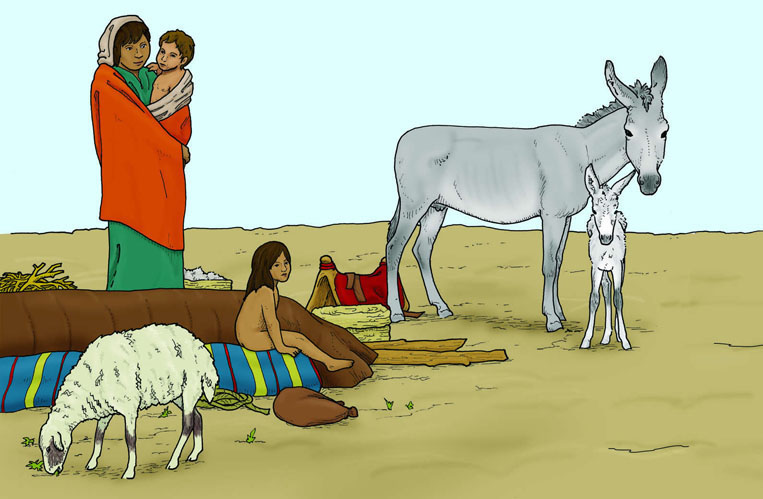Daily Life in Bible Times - Activity ideas
The T in T shirt
Show children the picture of the family at the time of Exodus. Ask them what they see and if they have any questions. They always ask why there is a child without any clothes on. Ask them if they think people had Pampers in the olden days. Ask them how long ago this was (probably 3500 years ago). Talk about how cloth was made: People had to shear the wool off the sheep, spin the thread, then weave the thread into cloth, then cut and sew the cloth into clothing. This is important information for children on many fronts. Often children in America and Europe don't know where cloth comes from. Interestingly, cotton came from Egypt. It might be fun to look up cotton processing with your child. Look up picking, processing, spinning and weaving cloth from cotton. Then look up how to cut and tailor clothing. This could be a fun project to spin off from the book: Go to the discount fabric store, let the child pick an inexpensive cotton. Get one yard. Measure the child's shoulders. Add 4 inches at each side and cut into two rectangular pieces. Have the child help you to sew the two pieces together, except for the neck hole, and (s)he can wear it. Ask the child if (s)he knows why a Tee-shirt is called a "T" shirt. It's because the original pattern is shaped like a T. It might also be fun to have the child paint on the shirt with cloth pens, available at craft stores, but that, of course, in not Biblical.
Food is Fun.
Look at the pictures of what the family is eating. Ask the child what strikes them. Do they have any questions? Everything in the book was purchased at an American super market. It would be great fun, especially for home-schoolers, to research things like bulgar wheat. What is it? How is it different from the kind of wheat we put into bread? Why is it a "whole grain" when it's also called "cracked wheat"? Go to the market with you child and buy some bulgar wheat. Also buy or make beef broth to cook it in. (Depending on how elaborately authentic you have time to be). Boil a cup of bulgar in a cup and a half of beef broth until the broth is absorbed (usually about 15 minutes). Let the child taste it. Add a pinch of salt. Talk about the difference in taste. Talk about where salt comes from. How do people get it? Where is it found. Add a dollop of plain yogurt to the pilaf. Let the child taste that. Talk about the difference. Talk about what yogurt is. Research how it's made. Use your imagination: add scallions, vermicelli, bits of vegetables you like, scrambled egg, taste each change with your child and talk about where each food comes from and whether of not people in the time of the Bible would have had that food.
Fruits and Vegetables.
Go through the pictures in the book and look at each kind of fruit, vegetable, olive, caper, and seed. Look up each one and find out where it grows, what kind of climate it requires, in what season it is harvested, and how it is processed for eating. You can do this exercise over and over with each individual fruit or vegetable. Just be certain you finish the research by buying, preparing, and eating the food. Make sure you point out how the people in the Bible times would have prepared and eaten it. Don't neglect the radishes!
Light and Dark.
In the section about Israelite houses in the period of the Judges and the Israelite kingdoms there are wonderful illustrations showing what archaeology has revealed about everyday life in ancient Israel. There is a picture of a little boy with an oil lamp. This is an opportunity to get your child to imagine being there. It's best to do this activity at night, but it can be done in a darkened room in the daytime as well. Take a candle in a glass like a yahrzeit or other candle that is manufactured within a glass (it's not advisable to use tea lites or other small, portable candles that can be dislodged from the glass container). Darken the room as completely as possible. Sit cross-legged on the floor with you child placing the candle on the floor in front of you. Light the candle. Show the child the picture in the book and explain that this is exactly how much light they would have indoors at night. Now's your chance to get your children to imagine themselves back into the Bible. There would be none of their modern inventions but plenty of time to sing songs, tell stories and share traditions with their family.
c
